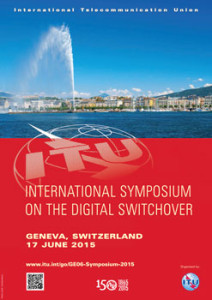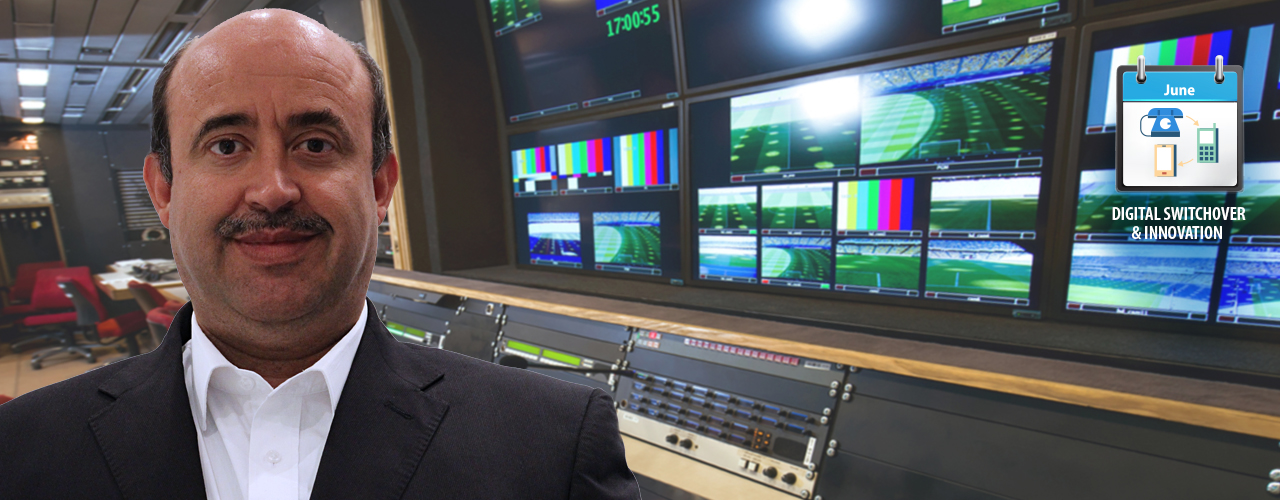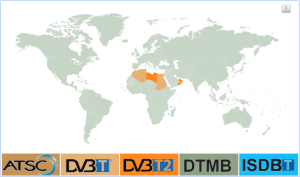Television is enjoyed by billions of people around the world, but viewers in Africa, the Middle East, Europe, and Central Asia (known as Region 1 at ITU) will soon be able to access a range of new services and programming thanks to the ‘digital switchover’. Bassil Zoubi is a career Engineer who has worked in the broadcast industry for decades and he shares with us why he believes this migration to digital television is important and looks at the wide-ranging impact it can have.
For consumers, the means of watching television (TV) is simple and has remained largely unchanged since the 1950s: push a button and news from around the world, memorable storylines and images of far-flung places are beamed directly to you. Yet behind the scenes, television is a complicated affair. Working as Head of Maintenance Engineer at Jordan Radio and Television Corporation until 1994, I have fond memories of rooms full of canisters of film, the whirring of video tape machines, towering transmitters with complicated wiring, and expansive audio consoles all working to air the programme schedule that was planned weeks before transmission. Yet, television is evolving as we move towards the digital era, and most of the equipment that I used is now obsolete.
This shift towards digital broadcast means that consumers can enjoy a wider variety of shows on multiple channels with a better quality of broadcast. It also facilitates reduced power and energy consumption, and spectrum efficiency which brings a host of associated benefits for consumers and broadcasters. But this shift from analogue to digital broadcasting also brings its own set of challenges.
Working as Head of the Terrestrial Transmission Department at Arab States Broadcasting Union (ASBU), I help to support the wide array of stakeholders involved, from stations to engineers and end-users, to ensure a smooth transition to digital broadcasting for the Arab region.
Digital Switchover
On 16 June 2006, a treaty agreement was signed at the conclusion of ITU’s Regional Radiocommunication Conference (RRC-06) in Geneva, heralding the development of ‘all-digital’ terrestrial broadcast services for sound and television. The digitalization of broadcasting in Europe, Africa, Middle East and the Islamic Republic of Iran by a target date of 17 June 2015 represents a major milestone towards establishing a more equitable, just and people-centred Information Society connecting the unconnected in underserved and remote communities and closing the digital divide. The new digital GE06 Plan provides not only new possibilities for structured development of digital terrestrial broadcasting but also sufficient flexibilities for adaptation to the changing telecommunication environment. For more information on the Digital Switchover, please click here.
Digital Dividend vs. Digital Switchover
The ‘digital switchover’ is the name given to the process of changing from analogue to digital TV broadcasting.
Many people today will be familiar with analogue broadcasting – having a restricted choice of programming due to limited space for channels; having to tune the TV to your region to ensure that you could pick up broadcasts; having to play with the antennae to get a smooth, uninterrupted signal – but as we move towards all things digital, this means of broadcast is becoming redundant.
With the advance of digital technology, we are now able to broadcast more efficiently in comparison to analogue. Firstly, analogue television broadcasts occupies a large amount of spectrum, a finite natural resource and the electro-magnetic ‘channel’ over which programming travels. Where a single analogue program can be broadcast on one transmission channel of 6 MHz to 8 MHz bandwidth, the same transmission channel could carry a multiplex of up to 20 digital programmes of equivalent quality. And, as spectrum is a limited resource, this is a valuable saving. The spectrum that is now being freed up as a result of the switchover is known as the ‘digital dividend’.
- What is digital broadcasting?
- The Digital Dividend: A Revolution in Technology?
- The Future of Digital Television
“The term ‘digital broadcasting’ is a catch-all term for the use of electrical signals for broadcasting that are a sequence of ‘discrete numbers’. Analogue broadcasting uses electrical signals that vary in a ‘continuous way’. The shift from analogue to digital is an inevitable one that has taken place in virtually all electronic systems over the past decades. Digital signals are much more flexible, can be squeezed into smaller spaces, and open up many more opportunities than analogue signals. The case for making the transition is as self-evident and beneficial as was changing transport from horses to motor cars. The change could bring a great deal more channels for viewers, the option of higher quality images, multimedia, and more involving and inclusive television.” Excerpt from ITU Blog, ‘The Future of Digital Television’. Read more here.
Christoph Dosch, Chairman of ITU-R Study Group 6, is an expert in the field of broadcasting. ITU asked him about the switchover from analogue to digital broadcasting and how this will affect consumers in ITU Blog, The Digital Dividend: A Revolution in Technology? Read the full interview here, or listen to the conversation in full here.
“The change from analogue to digital television broadcasting brings opportunities and challenges for all stakeholders, from manufacturers to broadcasters and end-users. The decision not only brings possibilities for structured development of digital terrestrial broadcasting but also sufficient flexibilities for adaptation to the changing telecommunication environment. As such, it represents a major milestone in the effort to connect underserved and remote communities and close the digital divide.” – David Wood, EBU. Read the full article here.
ASBU Role: Making the Switch
Broadcast transmissions involve many players in the chain – content producers, chain programmers, point-to-point links (e.g. between the studio and the transmitter station), manufacturers and end users. Consequently, a lot of investment, both in terms of money and time, is needed to facilitate the switchover.
While I believe that the existing infrastructure should be used to the largest extent possible, nearly 87 million households in the Arab Region will need new equipment, and thousands of stations will need to be renewed or replaced. Therefore, the transition to digital broadcasting will require a long harmonization process, but in order to go smoothly, it must involve all stakeholders as well as the media, telecommunication and frequency regulators and national legislators.
Arab States Broadcasting Union (ASBU) is key in bringing these players together and facilitating the digital switchover in the Arab region; we help to organize and coordinate the exchange of information and provide technical assistance to our members to ensure their smooth and harmonious operation. As part of this service, we have issued many studies and recommendations to help our members understand the advantages of digital transmission. We have conducted technology studies and investigated how the transition fits into our area, the best time for implementation and how to handle the challenges related to the digital switchover in the region.
Another key component of our role in the digital switchover in the Arab region is to help consumers understand how the change will affect them, and what benefits they can expect to enjoy once the switchover is complete. We have set up a hotline for assistance.
Most countries in the Arab region will not meet the 17 June 2015 deadline for the digital switchover. However, Tunisia, Bahrain, Algeria, Morocco, Kuwait and Saudi Arabia have shown strong leadership in the transition.
ITU News: Special Report on the Digital Switchover
 A special edition of ITU News (March/April 2015) charts the progress of different regions – Africa, Europe, USA, Latin America, and Asia-Pacific – towards the digital switchover, according to the timetable agreed by the 2006 ITU Regional Radiocommunication Conference in Geneva (RRC‑06). It also covers the preparations underway by ITU membership for the World Radiocommunication Conference (WRC‑15), which will be convened in Geneva, Switzerland, throughout the month of November. Read the issue here.
A special edition of ITU News (March/April 2015) charts the progress of different regions – Africa, Europe, USA, Latin America, and Asia-Pacific – towards the digital switchover, according to the timetable agreed by the 2006 ITU Regional Radiocommunication Conference in Geneva (RRC‑06). It also covers the preparations underway by ITU membership for the World Radiocommunication Conference (WRC‑15), which will be convened in Geneva, Switzerland, throughout the month of November. Read the issue here.
DSO Status: Arab States
This map shows the known progress of the Digital Switchover in the Arab States.
See the status of the transition to Digital Terrestrial Television Broadcasting in your region here.
The Digital Dividend: what are the benefits?
There are many benefits to making the switch from analogue to digital broadcasting. First is the reduction in power and energy consumption and the increase in quality of service (QoS) by providing consumers with better quality transmissions such as HDTV, achieved through the digital processing and compression of broadcasts.
However, the most valuable benefit both to service providers and consumers, is the amount of spectrum that is freed up once the switch has been completed: the Arab Region will have over 200 MHz spectrum from 694/698 – 790 MHz and 790 – 862 MHz. I expect that this surplus spectrum will be primarily be allocated for two purposes: additional local programming, and mobile services such as International Mobile Telecommunications (IMT).
In the Arab region, television is largely watched through live broadcasting services. Less than three per cent of television is currently viewed online or through on-demand services, mostly due to the limited scope of internet capacity and availability.
The Arab region is comprised of different backgrounds, and has a rich cultural history. As the dividend will facilitate additional local programing, I hope that this programming will be geared towards promoting a culture of tolerance and help to preserve these different communities.
The digital dividend is expected to be allocated for mobile services such as IMT, which will facilitate the further deployment of mobile broadband services in the Arab region, providing better coverage for highly dense and rural areas. As the Internet plays an important role in delivering a variety of services to customers, such as education and raising literacy rates, increasing the availability of mobile broadband will, in my personal opinion, have a positive impact on the region.
IMT
ITU has a rich history in the development of radio interface standards for mobile communications. The framework of standards for International Mobile Telecommunications (IMT), encompassing IMT-2000 and IMT-Advanced, spans the 3G and 4G industry perspectives and will continue to evolve as 5G with “IMT-2020”. IMT is an essential foundation of modern society, and brings the world to people in all countries – it is a truly global force for change and empowerment. Learn more about ITU’s role in the development of IMT here.
International Symposium on the Digital Switchover
 An International Symposium on the Digital Switchover will be held in Geneva on 17 June 2015.
An International Symposium on the Digital Switchover will be held in Geneva on 17 June 2015.
The Symposium will cover the following topics: objectives of the transition to digital TV– technical and regulatory frameworks; the Analog to Digital Switchover – stocktaking worldwide; advanced Technologies for Television; and building a sustainable ecosystem for Digital TV. The Symposium will conclude with a high-level round table discussion and will honor the contribution of outstanding persons to the Geneva 2006 Agreement. Learn more here.
Future of Broadcasting Spectrum
There are many elements that need to be taken into consideration when making long-term forecasts about TV broadcast spectrum use and availability, though I hope that the broadcasting band is preserved as it is the cheapest platform on which to access information.
I believe that all stakeholders must use this scarce resource efficiently to ensure that we can serve current and future needs. The current technological evolution is progressing at an extraordinary rate, with highly innovative techniques and new services being developed year-on-year. If broadcasting services use spectrum efficiently and effectively, there is room to accommodate both existing and additional services. Similarly, as new services develop new techniques, they must use this valuable resource efficiently, so as not to consume additional resources.
With this in mind, I don’t know what the future will hold for the future allocation of TV broadcast spectrum, but continued partnerships at both regional and international levels and coordination with governing bodies such as the ITU will continue to be necessary to ensure the efficient and appropriate allocation of this scarce and vital resource.
WRC-15
The 2015 World Radiocommunication Conference “WRC‑15 is a major opportunity to achieve the harmony which is one of my priorities for ITU’s work, and it is my hope that the Conference will achieve key consensual and harmonious outcomes, to the benefit of all.”
The World Radiocommunication Conference 2015 (WRC‑15) will be held in Geneva, Switzerland, from 2 to 27 November 2015.
WRCs are held every three to four years. The mandate of the WRC is to review, and, where necessary, revise the Radio Regulations, the international treaty governing the use of the radio-frequency spectrum and the geostationary-satellite and non-geostationary-satellite orbits. Revisions are made on the basis of an agenda determined by the ITU Council, which takes into account recommendations made by previous World Radiocommunication Conferences. The WRC‑15 agenda will also include an item on the spectrum requirements for global flight tracking for civil aviation, as requested by the ITU Plenipotentiary Conference 2014 (PP‑14).
WRC‑15 will consider the results of the studies on options to improve the international spectrum regulatory framework based on the effectiveness, appropriateness and impact of the Radio Regulations with respect to the evolution of existing, emerging and future applications, systems and technologies. Decisions will also be made on the most profitable and efficient ways to exploit the limited resource of radio frequency spectrum and manage satellite orbits, both of which are critical and increasingly valuable for the development of the global economy in the 21st Century
Learn more about WRC-15 here.


